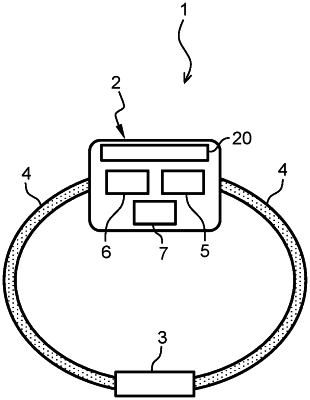| CPC A61B 5/02055 (2013.01) [A61B 5/0022 (2013.01); A61B 5/024 (2013.01); A61B 5/026 (2013.01); A61B 5/1112 (2013.01); A61B 5/14532 (2013.01); A61B 5/14542 (2013.01); A61B 5/681 (2013.01); A61B 5/742 (2013.01); A61B 5/746 (2013.01); G16H 10/60 (2018.01); G16H 40/67 (2018.01); G16H 50/30 (2018.01); A61B 2560/0214 (2013.01); A61B 2562/0271 (2013.01)] | 20 Claims |

|
1. A smartwatch-type individual medical monitoring device configured to come into contact with a wrist of a user, comprising:
a main body provided with a display screen;
a bracelet linked to the main body;
a measurement instrument configured to be positioned opposite a radial artery of the wrist of the user, when the medical monitoring device is worn by the user, the measurement instrument comprising:
a first sensor configured to continuously measure an oxygen level at the radial artery of the wrist of the user;
a second sensor configured to measure a heart rate of the user by measuring vibrations of a blood flow at the radial artery of the wrist of the user;
a third sensor configured to measure ascending and descending blood flows at the radial artery of the wrist of the user;
a processor configured to:
acquire the measured data of the first sensor, second sensor and third sensor;
analyze the oxygen level measured by the first sensor and compare a measured value of the oxygen level to a first predetermined threshold;
analyze a number of vibrations of the blood flow measured by the second sensor and compare a value of the heart rate to a second predetermined threshold;
analyze the ascending and descending blood flows measured by the third sensor, compare a value of the ascending blood flow to a third predetermined threshold and compare a value of the descending blood flow to a fourth predetermined threshold; and
output on the display screen information indicating a detection or a non-detection of an anomaly in accordance with the analysis of the oxygen level, the heart rate and the ascending and descending blood flows of the user; and
wherein the processor comprises a storage medium to store the measured data of the first sensor, the second sensor and the third sensor.
|